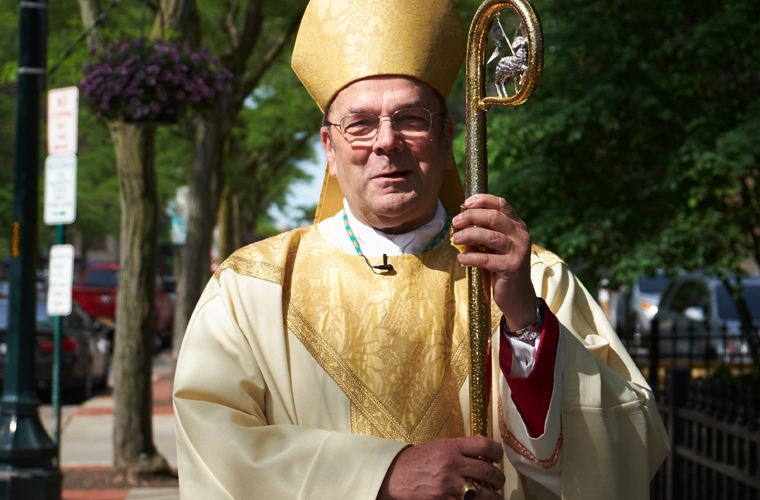“The history of the Church has not been driven by theologians, or priests, or nuns, or bishops. Maybe in part, but the true heroes of the Church are the saints. This is those men and women who devoted their lives to making the Gospel a reality” (Pope Francis, Interview in El Pais, January 22, 2017).
“Repent and believe in the Gospel” is one of the formulas that may be used during the distribution of ashes. Although we may be more familiar with the traditional formula “Remember that you are dust, and to dust you shall return,” the alternative phrase aptly describes our Lenten journey. Repentance — sorrow for past transgressions — is an important piece of the conversion to which we aspire. As we repent and turn away from sin, we turn to the Gospel, “the power of God leading everyone who believes in it to salvation” (Rm 1:16). Lent is the opportune time to admit that we are sinners who are called to turn more fully toward the Lord and live the Gospel.
We all benefit from the good example of others. Who are some of the March “heroes” who made the Gospel a reality? Saint Patrick and Saint Joseph certainly come to mind! Before we consider them, however, let’s take a look at lesser-known saints.
Saints Perpetua and Felicity lived in the latter years of the second century and were martyred in 203. Perpetua was a prosperous young woman of 22 and Felicity was her young servant. Both were arrested and suffered martyrdom for violating a prohibition against conversion to Christianity. The accounts of their martyrdom attest to their bravery and joy in the face of suffering. Their proudest boast was to be followers of Christ at a time when adherence to Christianity was a crime against the state and often resulted in death. Perpetua and Felicity accepted their fate courageously and are remembered as “the bravest and happiest of martyrs” (Office of Readings, Memorial of Saints Perpetua and Felicity).
“Whoever wishes to be my follower must deny his very self, take up his cross each day, and follow in my steps” (Lk 9:23). It is unlikely that we will face martyrdom, but if we intend to follow Jesus we must be ready to take up His cross each day. In a sense, this is a daily martyrdom, a daily offering of our life in order to gain life.
It is not easy to live as a Christian, to be a committed follower of Jesus. Perpetua, Felicity, and a host of martyrs who gave their lives for their faith through the centuries, and who even today in the war-torn countries of the Middle East suffer and die for their faith, remind us what it means to be a disciple. We need their example and inspiration. During Lent we ask the martyrs to help us on our journey to accept the cross in whatever form it comes to us.
Saint Frances of Rome (1384-1410) was born into a noble family and married a man of wealth. She was a devoted wife and mother. Frances spent her free time nursing the sick in a local hospital. “As outbreaks of the plague and the violence of civil war moved closer to her world she sold her jewels and turned part of her home into a hospital. Her practical skill in managing a household and her attention to others were combined with a life of prayer” (This Day, March 9, 2017).
Frances was committed to the sick and the stranger. The gifts God bestowed upon her “were for the spiritual and physical advantage of her neighbor. In a few sentences she could bring consolation to the afflicted and the anxious, calm the restless, pacify the angry, reconcile enemies and extinguish long-standing hatreds and animosities” (Office of Readings, March 9).
Frances reminds us of the importance of almsgiving — giving not only our material possessions but also our time. Reaching out to our neighbor through the practice of some of the Corporal and Spriritual Works of Mercy will help us to live and to witness to the Gospel more fully.
Saint Patrick (389-461) needs little introduction! Well, at least I think he needs little introduction. There may be a few people out there who need a bit of information about this “hero” of March. Patrick is remembered for his role in passing on the Christian faith in Ireland. Patrick was born in Roman Britain, kidnapped, and taken as a slave to Ireland. He suffered hardship but remained faithful to his Christian faith. Patrick managed to escape and return home. After studying for the priesthood he had a dream “in which Irish voices, the voices of those who had stolen his youth, cried out for him to return” (This Day, March 17). In 432, Patrick returned to Ireland and devoted himself to the spread of the Gospel throughout Ireland.
Pope Francis often tells us we are called to be “missionary disciples.” Following Jesus means we are “sent forth” as He was to bring the good news of salvation to others. Consider Lent as a time “to build up the Church” by proclaiming the good news of salvation to others. This proclamation is often through example rather than words. In the words of St. Francis of Assisi, “Preach the Gospel and if necessary use words” (St. Francis of Assisi).
We cannot speak of the saints of March without mentioning Saint Joseph. What do we learn from him? How can he help us to make the Gospel a reality? Joseph was a great listener. We have no recorded words of his in Scripture but we know he listened well. He listened to the angel who told him he should take Mary as his wife. He listened again when he was told to take his family to safety in Egypt. He listened yet again when he was told to uproot his family and take them home. Joseph listened to God’s word and acted upon it.
Years later Jesus would describe his brothers and sisters as those “who hear the word of God and act upon it” (Lk 8:21). Joseph was a great disciple and he showed us the path to follow if we want to be a disciple: listen to God’s world and act on it.
The “heroes” of March and many other saintly heroes with whom we are familiar are ready to accompany us on our Lenten journey. Let us invite them to walk with us during this sacred time of renewal.
If you have a prayer intention you would like me to consider during the weeks ahead, please mail it to my attention at 240 E. Onondaga St., Syracuse, N.Y. 13202.





